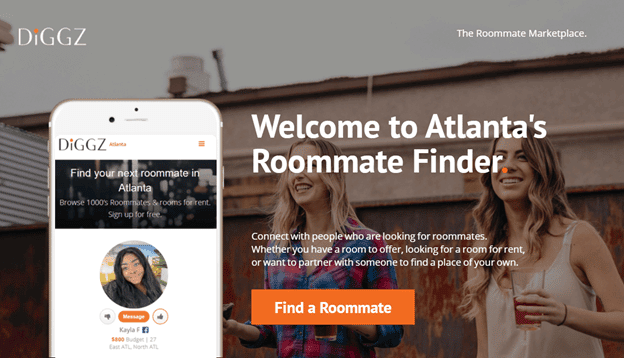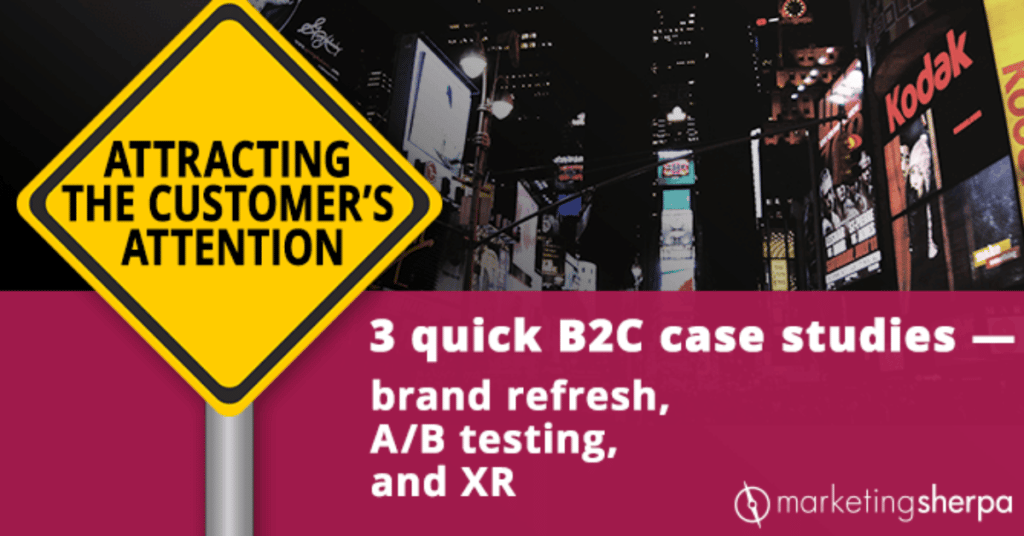by Daniel Burstein
July 12, 2021

First you have to attract attention.
This is the very beginning of any customer journey.
In fact, the most important element of an effective advertisement is its ability to capture attention, according to the MECLABS Ad Messaging Index heuristic (you can learn how to use this framework for optimizing advertising in Display Ad Optimization: How to lower your CPA consistently with the right copy and imagery).
So in this article we bring you three case studies of how companies are attracting attention. First up, how Bumble Bee Seafoods’ brand refresh grabbed a new generation of consumers. Then, how an app used A/B testing to discover how to get visitors’ attention at the top of its PPC landing pages. And finally, how the Tennessee Titans captured the attention of consumers thanks to major advancements in AR technology.
Quick Case Study #1: Bumble Bee Seafoods attains its first profitable year in five years by rebranding
Bumble Bee, an ocean-inspired collection of brands, was in need of a brand refresh and overall help with driving sales. The team wanted to create a clear message centered around refreshed product brands and sustainability to drive growth and relevancy.
In other words, packaged tuna was no longer a relevant food option for younger consumers.
The team engaged in customer research and discovered an opportunity to elevate the relevance of Bumble Bee’s products as a healthy protein source for a wider group of younger consumers.
The consumer goods company updated its brand messaging, social good strategy and design. Since Bumble Bee is a global seafood company, the team developed a sustainability strategy focused on the company’s social responsibility in the world’s oceans and sea life.
Here is some of the new marketing messaging from the consumer goods company’s website aimed at grabbing the attention of younger consumers:
“Seriously. It’s packed with lean, powerful, muscle-building protein you don’t need to blend, crack, shake, or bake. It can be as portable as a granola bar — minus the crumbs, plus a handy spork. It’s a stress-free snack. It’s fast food without the drive-thru or delivery fee. It’s the superest (and most affordable) of superfoods. And one of the tastiest of all seafoods.”
“What fuels your workout? Protein power, not powder. No shaker required. Our Albacore packs 29g of lean protein per can.”
“A granola bar won’t get you as far. No crumbs. No sugar crush. Just portable, energy-packed tuna. With a spork.”
“A wealth of health. Super Affordable Superfood. A healthy option without the hefty price tag.”
“No drive-thru. No delivery fee. Faster Than Fast Food. And more affordable. And already in your pantry.”
Creative Sample #1: Messaging on Bumble Bee’s website

Creative Sample #2: TV commercial for Bumble Bee (as seen on YouTube)

“Bumble Bee’s strategic repositioning on shelf and in market happened to coincide with consumers searching for, and stocking up on healthy, shelf-stable proteins as COVID swept the country. The brand’s refresh enabled retailers to see the category as an opportunity to reach a younger audience and take a fresh look at the overall category,” said Shawn Parr, Chief Strategy Officer, Bulldog Drummond, an Envoy company (Bumble Bee’s branding and messaging consultancy).
After working for almost two years to develop the growth strategy, the company had its first profitable year in more than five years.
“If you’re a brand struggling with relevance, everything starts with revisiting the reason for being, your brand strategy and your position in the market,” said Todd Putman, Chief Growth Officer, Bumble Bee. “Going back to the basics was key. By starting from the beginning and removing all other opinions to unleash the truth in every facet, we were able to successfully reboot and refresh the brand. Having the mindset to not be afraid to start from scratch is something that I recommend every marketer keep in mind when launching a campaign.”
Quick Case Study #2: Roommate finder app increases conversion 10% in A/B test by adding value proposition information
Diggz promotes its roommate finder app with PPC (pay-per-click) campaigns that send traffic to dedicated landing pages.
“Using Unbounce, I like to test page elements such as hero photo, header, CTA (call-to-action) button, and extra elements or sections – making the landing page longer with more to read, or short and sweet. We also do some A/B testing on non-landing pages via Google Optimize,” said Rany Burstein, CEO and Founder, Diggz (Editor’s note: Burstein is not related to the writer of this article).
The team ran an A/B test for a mature landing page design that was already getting 20% to 30% conversion rates, depending on the market.
Creative Sample #3: Before (control) landing page for app

In the top section of both desktop and mobile pages, the team inserted a screenshot with text and imagery showing how the app works to enhance the app’s value proposition and grab visitor’s attention.
Creative Sample #4: After (treatment) landing page for app

The treatment garnered a ~10% higher conversion rate across the campaigns.
“Since this is new, we are also testing the ‘featured user’ we display within the screenshot as well. A happy or smiling female face seems to work better (majority of our members are females). But that’s no news to veteran marketers,” Burstein said.
Another A/B test the team ran recently added a “How it works” section into the PPC campaign’s landing page. They wanted to see if adding more value proposition information upfront will help those users that are still not sure what to expect from the app’s services, or whether the added friction will distract them and hurt conversion.
Creative Sample #5: Added section in treatment landing page for roommate finder app

For most campaigns, the team found that the added section increased total conversion rates by five to seven percent.
“It might be helpful to allow the potential user to visualize and understand your product, service or app before asking them to sign up, give their email or make a purchase – especially for PPC search ads where there is already only text to draw in the user,” Burstein advised.
Quick Case Study #3: Tennessee Titans reach 2.2 million people on Twitter using an XR immersive experience
With the 2020 NFL season approaching, the Tennessee Titans were faced with a unique situation due to COVID-19 restrictions that didn’t allow fans into their stadium for opening day. However, the Titans’ marketing team wanted to find a way to still engage fans and residents to make them feel a part of the season.
“Like many businesses, we were challenged with finding innovative ways to engage with our fans during the pandemic. So many of our fan initiatives have traditionally culminated into events built for large groups of people, so the shift towards virtual interactions forced us to be more creative and ultimately gave us new opportunities to engage fans differently,” said Jennifer Hinkle, Sr. Director of Marketing and Digital Strategy, Tennessee Titans.
The team felt that murals were a big attraction in Nashville and had eyed a project incorporating murals into their marketing campaign for some time. With pandemic restrictions in place, they decided the timing was right to use virtual interaction with a mural to engage fans and still allow for social distancing. The team commissioned local muralist MOBE to create a 135’ x 26’ mural in downtown Nashville called “Tennessee Tough.”
Creative Sample #6: Football team’s mural

To engage fans, the team wanted to bring the mural to life and add an extended reality (XR) immersive experience. They used WebAR (web-based augmented reality) technology – the first NFL mural to incorporate AR tech.
WebAR has overcome the challenge of getting consumers to download a native application to run an experience by allowing full AR experiences powered by the web, with no need to download an application.
“Using WebAR enabled us to bypass a major barrier to entry – downloading apps. Consumers’ attention spans have dropped to seconds over the years, and this experience showcased how ease-of-use and simple user experiences when using augmented reality results in greater fan engagement, social shareability, and overall brand exposure. Being able to create a modular, immersive AR experience without the need of a third-party app download is incredibly powerful and scalable,” said James Giglio, CEO, MVP Interactive (the Titans’ extended reality tech vendor).
Fans simply scan a QR code from one of the many sidewalk decals located around the mural or visit titansmural.com on their mobile device. They are then instructed to allow camera access and point their camera at the mural, which animated the AR experience once they tapped on the screen.
When viewed through a phone, the web-based augmented reality experience brought the mural to life. Key components of what someone experiences include:
- A football player with his arms wide, “615” (Nashville’s area code) as his jersey number and “Nashville” on his name plate
- Quotes from significant Tennessee figures such as John Lewis, Pat Summitt and Wilma Rudolph, ending with the words “Tennessee Tough” surrounded by counties
- A representation of all 95 of Tennessee’s counties, painted on the mural and illustrated in the AR experience.
“The Titans Mural was the perfect blend of encouraging people to safely go outside to experience the mural in person, but also get to have this unique augmented reality experience where they could witness it come to life,” Hinkle said.
Creative Sample #7: Football team’s mural as seen through a phone using WebAR

Creative Sample #8: Football team’s mural as seen through a phone using WebAR

The mural drew inspiration from the recent challenges and change Nashville experienced from tornados, the pandemic, and social justice dialogue.
“The ability to change the AR experience periodically also allows us to keep the mural experience relevant and celebrate big moments in our annual calendar. The imagery of the mural itself, with the inspirational quotes from influential Tennesseans and representation of each county in Tennessee, was a symbol of community and hope during a difficult time for our city and state,” Hinkle said.
The mural spiked awareness and engagement with the Titans, resulting in more than 1.2 million Twitter impressions, a reach of 2.2 million people on Twitter, 48 earned media stories, and more than 1.5 million media impressions.
“In a city known for its murals, we were proud of how the Titans Mural stood out and to be the first NFL team mural to incorporate AR technology,” Hinkle said.





